Artist Interviews 2023
Lesley Oldakers 
By Julia Siedenburg
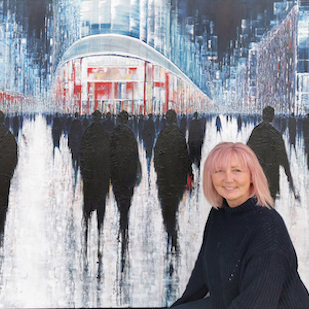
Lesley Oldakers works of art hold an emotional intensity that you cannot escape. There is a sense of beauty and familiarity when looking at these glimpses in time, full of people. Maybe it is nostalgia, remembering the feeling of belonging somewhere, to someone. At the same time, it can bring a feeling of loneliness or uneasiness, especially when remembering the situation we all found ourselves in not too long ago.
Inspired by her own experience and emotional journey as well as significant locations from events and themes that influenced the world, these pieces are created to speak to each viewer based on their being. And that is what makes her work so truly beautiful.
Her mystical subjects are sometimes closer to a shape than a detailed human figure, though no matter what they look like they do play a very specific part in these narratives.
I am so incredibly thankful that she agreed to tell us a little bit more about her craft. I hope you enjoy this interview as much as I have, dear reader!
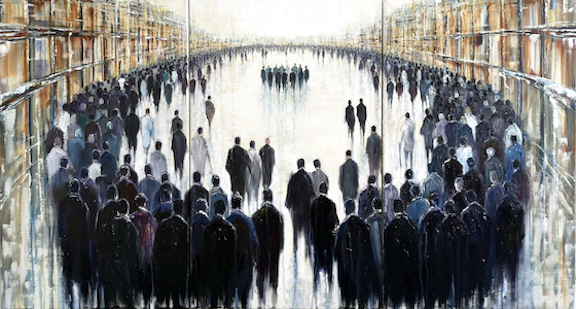
When I first came across your images I was mesmerized and extremely moved. There was an emotional wave that came over me that I still cannot quite explain. I think it is because it made me think about the feeling when you feel lonely in a crowd of people.
What would you like people to feel and learn when they see your work?
My paintings are places where I can lose myself within the inner conversations that emotionally torment me. So, I guess, I would like for people engaging with my work to have the same emotional connections and for them to feel a sense of comfort in that they are not alone. My work can be quite dark but also shows hope.
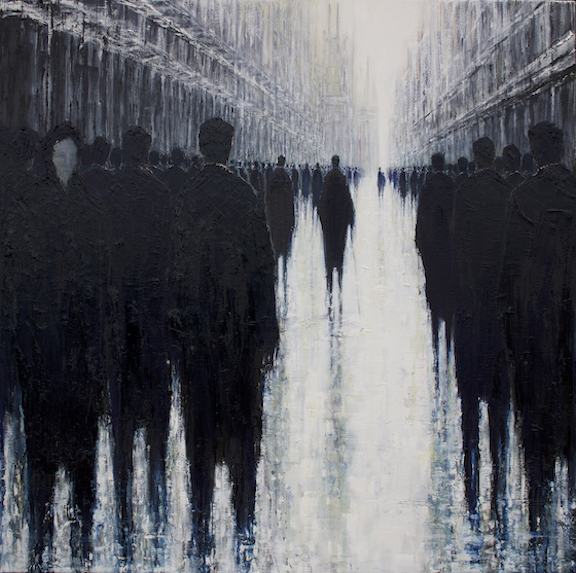
Your texture work is phenomenal. It gives the images so much depth and reality. It makes the subjects seem to be real people wearing real clothes and not just figures on a sheet. How did you find your style?
I have always had an interest in people and how we all connect to each other and our surroundings. My painting process is a continuation of these thoughts which led me to want to create suggestions rather than representations of people. My style, I guess started at art college where I experimented using blurred black-and-white analog photographs of the shapes of moving crowds of people to translate into large oil paintings. The forms and marks loosely suggest people and their connections. I love the materiality of oil paints and how they can be washed or thick impasto and I use these material properties in my painting process. The figures literally build up from the background using brushes and palette knives, almost like sculpting, to appear and show their presence.
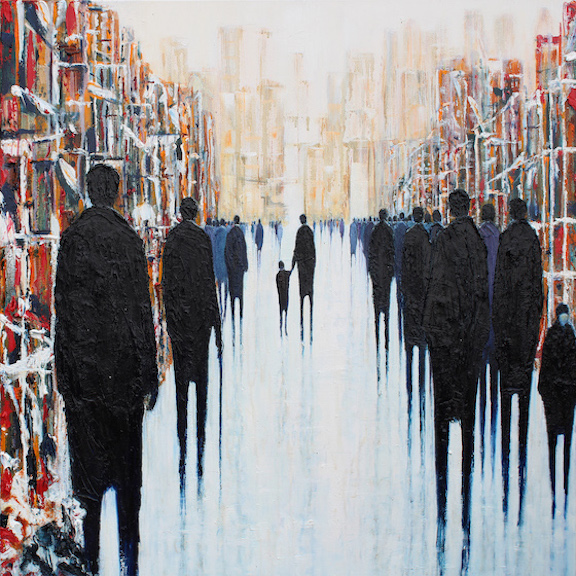
Your work focuses on groupings of people. People walking in and through crowded places. What inspired you to do so?
I suppose my work started focusing on the unseen person in a crowd when I moved to Zurich after art college. I didn’t know anyone, couldn’t speak the language, and felt quite isolated. I used to spend time sketching and photographing people in the train stations and internally exploring the lives of individual people walking past. You see people in groups all the time, but I started questioning…are they lonely underneath the surface…they appear to belong, do they feel they belong…and do we need to belong? My own personal life experiences then started to overlap with my observations and thoughts and my paintings evolved
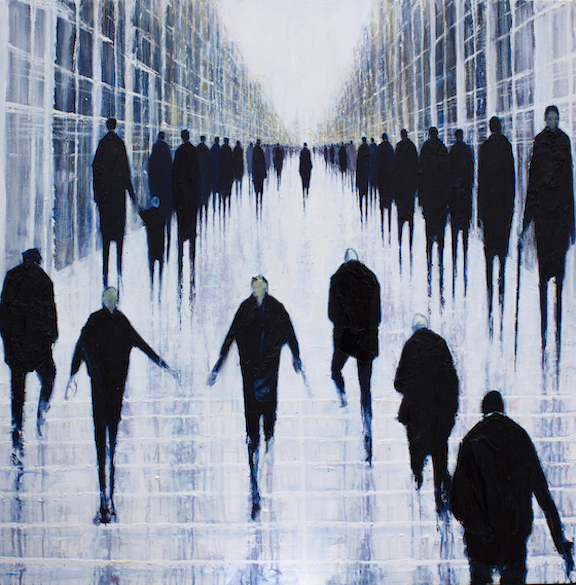
These art pieces are mostly held in black and white as the contrast of shadow and light, yet on some pieces, there are pops-up colors used in the buildings or people.
How do you choose the colors that you use and what motivates you to use them?
My earlier work was more monotonal with just splashes of colour to express a sense of life and movement in a crowd but as I gradually progressed in my paintings, more colour appeared in my work.
I think it is because over the years, I have learned more about colour theory, and I am more confident to use colors to evoke different emotions and narratives in my work.
There is always so much more to learn and explore being an artist. It is a never-ending, exciting creative journey of discovery…

Some of your background settings come across as mystical places taken from the imagination and then some remind you of real locations. How do you choose your locations?
If it is an emotional theme or narrative I am trying to paint, then the place is usually from my imagination. For example, Environmental climate crisis, Gender, LGBTQ and racial inequalities, and mental health.
If the narrative is specific to an event or narrative from a particular place, then I try to make subtle suggestions to this in the background. For example, the series I did on the Syrian conflicts, changing China, and the commission ‘Sonder’.
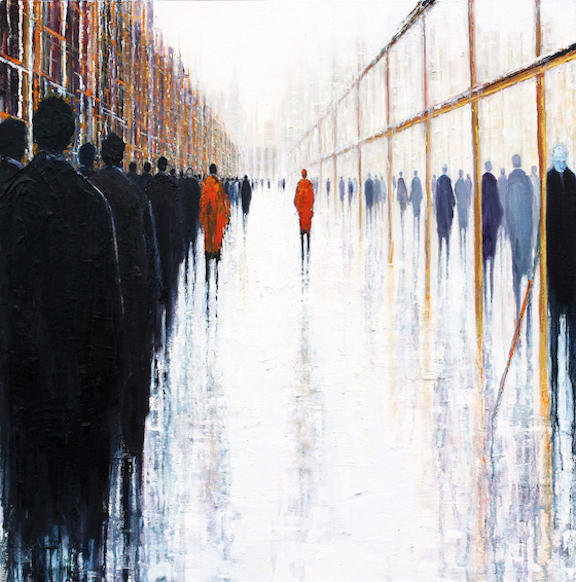
The amount of detail in your subjects varies from image to image. Some faces are very clearly drawn, and other persons are more just shapes that float in the picture.
Do you have to be in a certain mood to create your work and are the details connected with your state of mind at that moment?
Yes, I do have to be in a certain mood to paint because I need to attach my inner emotions to the work and If I’m not in that space then I cannot connect. Some of my work is a reaction to events I see around the world, so I need to put myself in the space of the painting and walk amongst the crowds to feel what it is like to be that person.
I often paint a forward-facing figure in the peripheries, which represents my presence as an observer and hopefully a stopping point for the viewer to engage and observe too. Some of my work is more of a personal expression and a way of coping with my own mental health issues.
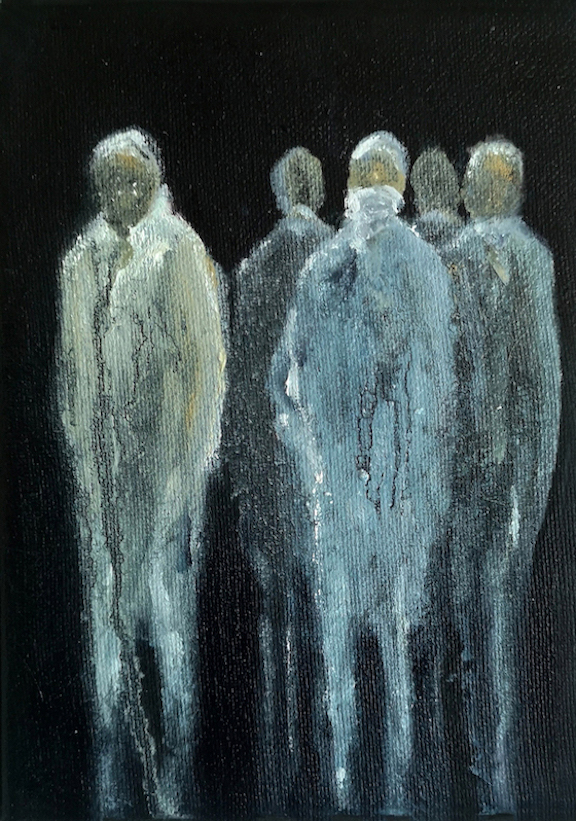
In your series ‘Isolation ‘your whites and blacks were switched. Now the background is completely dark, yet your subjects are seen in white as it is usually the opposite.
What motivated you to create this specific two-part series?
The “Isolation” series of paintings were done over the Covid lockdown and was a response to the loneliness and loss everyone was experiencing. I did my first negative painting called In Our Absence, to try and suggest the loss of life and the traces of presence it leaves behind. I suppose for me, my negative paintings symbolize something missing, but which is still there in our memories.
I also did an installation piece for the Stockholm Supermarket Art Fair last year with ArtCan, an art group I belong to. It was layers of fine gauze with life-size positive and negative figures painted on to represent the missing father figures in my life. It was called ‘Absent Father.’
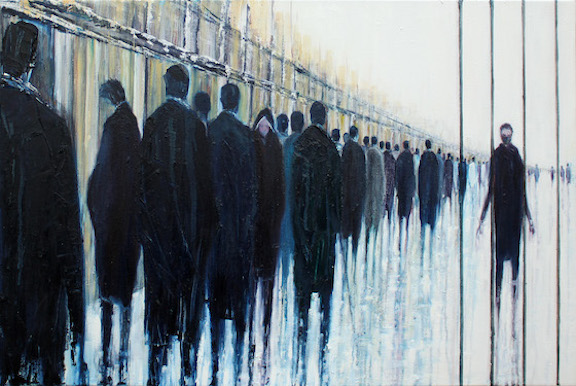
Please tell us a little bit about your childhood and upbringing.
As for my childhood, I was always creating things and often lost in my own thoughts, so no surprise that I am still doing that now. I grew up in the city of Bath, UK until I went off to university to study, met my soul mate, worked, and traveled.
My mum has always encouraged and supported me to pursue all things I have done. She has been my rock and role model throughout my life. As unmarried, single women in the 60s, she must have found it hard bringing up a child on her own back then; but because she was such an amazingly strong woman, who never gave up, I can be thankful to her for who and where I am today.
Sadly, she has developed Alzheimer’s, so it is my time to support her now. I have started a series of works to help me express my feelings about this awful disease that affects many people. Life can be a lonely place for some of us.
I struggle with mental health issues but luckily, I have managed to find help and support when I need it. I think my experiences may be why I am interested and drawn to explore the hidden peripherals of society in my work. I try to understand and empathize with other people’s struggles in life and my hope is that they can find some sort of connection and comfort in my work. As a random bit of information, I wasn’t always an artist. I started out my career as a Medical Biochemist, which I did for 13 years and loved it. I painted as a hobby back then. It was not until after I had my children, that my art career really started and when I was able to go to art college as a mature student. But hey, doing it this way around meant I had many more life experiences to inspire and explore in my paintings. I now have 4 grown-up children of my own and a granddaughter, plus all their partners and pets, so life is always crazy and buzzing in our family, but I love it.
The crazier the better…I say…
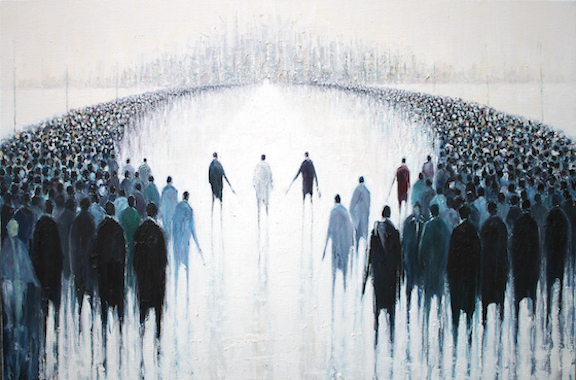
Which piece is your favorite and why?
Oh, That’s a hard one…. I guess it would have to be the one that was the most exciting to do. “Mutual Benefits”. Thomas Sadoski contacted me on Instagram. He liked my work and asked if I would create a painting for the stage set of a play he was directing in NYC. I was sent the script to read, which was brilliant, and I painted my interpretation of the narrative and the characters of the play. He loved it and the painting is now in his collection. It was such an awesome and interesting collaboration, and I was really grateful for the opportunity. Sadly, the play got postponed due to the covid outbreak.

What is next? Are any shows or new series planned in the near future?
Next for me this year, is the Flux exhibition in London in May, then a move to Minneapolis in September and finding a new studio to work from….and hopefully a US gallery to sell my work.
My work is in lots of galleries in the UK and Ireland, and I sell a lot of work directly to US collectors, so it will be great to have a base there soon.
As for my work, I am hoping to do a series of larger canvases this year. I miss the freedom it brings when painting on a larger scale. I did an art residency In China, where I painted some huge 2-3m paintings and loved them. The trouble is finding a space big enough to paint in that scale…fingers crossed that I find a big new studio in Minneapolis.
Thank you so much for this opportunity to talk to you about me and my work…
|
|

